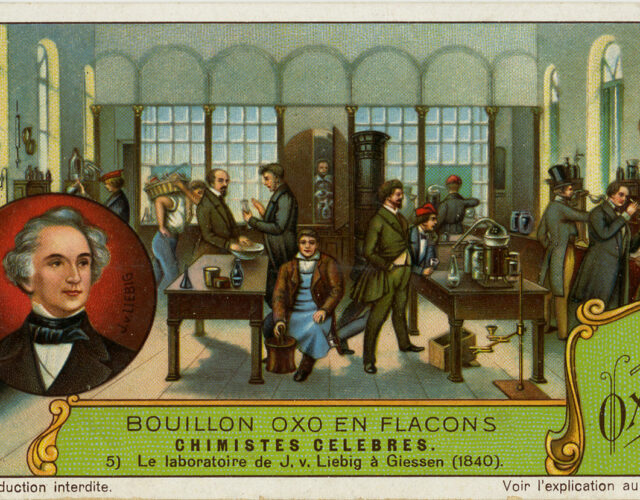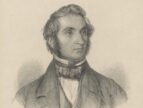By the time Justus von Liebig started boiling beef down into jars of brown goo, the German professor was regarded as one of the great chemists of the 19th century.
Liebig had made a name for himself in agricultural chemistry, most specifically by identifying nitrogen as essential to plant life. He also established the first rigorous, lab-based school of chemistry at the University of Giessen (now named Justus Liebig University Giessen).
Liebig’s fame was lasting. Nowadays he is considered a founder of organic chemistry, and the journal he created in 1832, Annalen der Pharmacie (today’s European Journal of Organic Chemistry), is still important in the field. His name is even attached to a concept in agricultural chemistry, Liebig’s law of the minimum, although contemporary scholarship revealed that Liebig was the popularizer rather than the progenitor of this principle. But back to that beef boiling.
Having reduced the building blocks of plant life to a list of nutrients, in the 1840s Liebig started working on a more literal reduction—meat extracts he hoped could inexpensively provide nutrition to Europe’s poor. By 1847 he had a usable formula for manufacturing a beef-based extract, but he ran into a problem: raising cattle was expensive in Germany, too expensive to supply the material his formula demanded. Different ratios have been cited for this formula, but roughly 30 pounds of meat were needed to create just 1 pound of extract. Without a viable commercial option Liebig offered his formula freely to the world and promised to go into business with anyone who could make the math work.
Over the next 15 years pharmacists produced small-batch versions of Liebig’s extract as tonics, often using the inventor’s name to sell their wares. Schemes came in from around the world, but all were rejected until 1862, when a young Belgian (or possibly German) roadbuilder in South America struck on a feasible plan.
The story goes that George Christian Giebert noticed that leather makers in the pampas, after skinning their cattle, left the carcasses to rot. True or not, this area was an ideal place to set up a meat-processing operation: plenty of cheap land; a cattle industry already in place; and the new port town of Fray Bentos, about 100 miles up the Uruguay River from Buenos Aires, ready to ship anything that could be bought or sold.
After a few years of negotiating with Liebig, Giebert bought land and cattle and set up a small factory in Fray Bentos. At the factory cattle flesh was pulped using iron rollers and then soaked in hot water; the fat was then skimmed off from the resulting liquid. Adding pressure and heat turned this soup into a thick, molasses-like concentration. The first batches arrived in Europe in early 1865, and by the end of the year Liebig and Giebert had a £150,000 loan and a new company: Liebig’s Extract of Meat Company. Liebig was named scientific director and given a lump sum of £5,000; a salary of £1,000; and 2% of the company’s profits for 5 years.
The company first marketed its products through physicians and apothecaries, promoting its medicinal and nutritional virtues. “Meat teas” made from Liebig’s extract addressed “all cases of weakness and digestive disorder,” according to the company’s advertising, and allayed “brain-excitement” when served as a nightcap. Liebig didn’t shy away from promoting his invention’s medicinal value. In an 1854 issue of his journal (by then renamed Annalen der Chemie und Pharmacie), Liebig claimed meat teas could cure advanced typhus and inflamed ovaries, assertions he repeated in other publications. In 1868, after his South American enterprise had begun selling meat extract across Europe, he dedicated space in his journal for a soup recipe made from Liebig’s meat extract.
Many physicians joined Liebig in praising the curative powers of meat teas. The English seem to have been particularly enamored with these concoctions. After sampling one of the first jars of the manufactured extract in 1865, members of the Royal Medical and Chirurgical Society of London wrote that the “whole medical profession owe[s] a deep debt of gratitude to Liebig for having put into their hands a means of giving their patients the nutritive parts of animal food in a remarkably concentrated form.” By the late 1860s St. Thomas Hospital in London reported using 12,000 pots of the stuff each year.
There was one problem: there really wasn’t much nutritional value in all those pots. As the extract grew in popularity, skeptics started to question its value. Chemists who tested Liebig’s creation found it contained very little in the way of fats and proteins. Many condemned the company for duping shoppers in its advertising, particularly the claim that 34 pounds of meat were used to make a single pound of extract. Such advertising, critics argued, misled people into thinking they were consuming 34 pounds’ worth of beef nutrients with each jar.
According to historian Mark Finlay, one experiment designed to uncover the extract’s nutritional failings caused an uproar at the time. A German physiologist named Edward Kemmerich fed dogs a diet consisting solely of meat extract. All the dogs died. When Kemmerich published the results of his experiment in 1868, he declared Liebig’s extract poisonous. (This conclusion, suspiciously, didn’t keep Kemmerich from producing his own brand of meat extract later on.)
As these attacks increased, the Liebig company changed tack, marketing the product not as a medicine but as a delicious palliative capable of easing a troubled stomach and mind. And the company promoted it as a quick and easy way for overworked cooks to make a delicious, meaty stew. “NOTICE,” reads one advertisement in the Institute’s collection, “a first class French Chef de cuisine lately accepted an appointment only on condition of Liebig Company’s Extract being liberally supplied to him.”
This change in marketing proved shrewd. By the early 1870s the extract was a staple in middle-class pantries across Europe, and the company expanded its offerings to include canned corned beef and canned beef tongue. By the end of the decade Liebig’s firm was churning out 500 tons of extract each year. The extract remained popular through World War II and still exists today, manufactured by Liebig Benelux.
As part of its advertising push, the Liebig company began producing trading cards in 1872, a year before Liebig’s death. These full-color lithographs were nothing short of a sensation. Demand was so great by the 1880s that customers often were required to show proof of purchase to receive the cards, something unheard of at the time. It was one of the great advertising campaigns of the Victorian era.
For the next 100 years the company was bought and sold again and again and diversified into other industries, but still it continued to churn out trading cards. All told, more than 11,000 cards were distributed in 14 countries. The range of subject matter in the cards is remarkable. They reveal the Victorian era’s latest inventions, exotic fauna and flora from the far reaches of the world, marvels of antiquity, and vignettes from the world’s great capitals.
A French series of cards on the history of chemistry, an example of which is shown above, is of obvious interest to Distillations’ readers. The series culminates with a tribute to the great man himself. We find Liebig in a lab full of well-dressed helpers, discovering, we must assume, the delicious mysteries of condensed meat.







